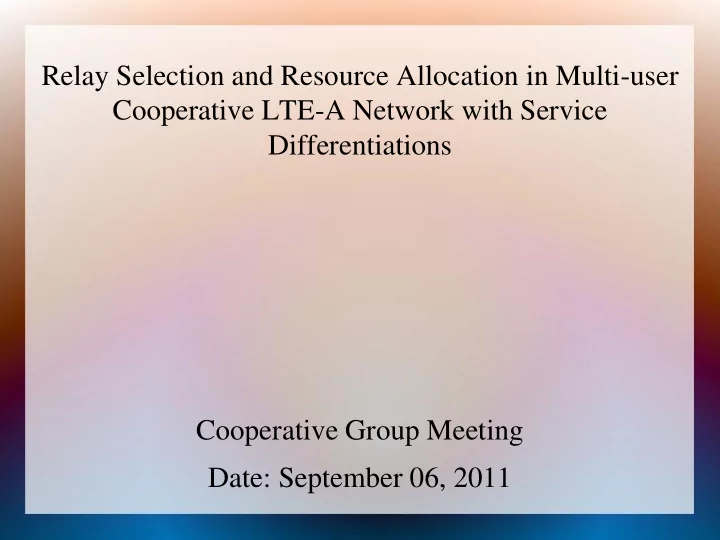

Relay Selection and Resource Allocation in Multi-user Cooperative LTE-A Network with Service Differentiations Cooperative Group Meeting Date: September 06, 2011
Outline ● Motivation ● System Model ● Solution Approach ● Simulation Parameters ● Results ● Conclusion
Motivation ● 4G services – Person-to-person communication – Content delivery – Social networking – Business services ● Diversified applications and high data rate requirements ● Cell edge throughput and coverage ● MIMO, Carrier aggregation, CoMP ● Cooperative communication
Relay types ● Type-I – RS can help a remote UE which is far away from eNodeB – Needs to transmit its own reference signal, control information for eNodeB – RS has the full functions of an eNodeB except backhauling ● Type-II – RS help a local UE unit which is located within the coverage of eNodeB – UE has a direct communication with eNodeB – Does not transmit common reference signal or control information
Relay types(2)
System Model • Consider an LTE-A uplink • K users are uniformly distributed • N fixed relays are uniformly distributed at a distance 0.5R from the eNodeB • The destination node(eNodeB) has perfect CSI of SD link and all RD links • Regenerate and forward • eNodeB use MRC
Problem Formulation ● Our objective is to maximize the total system throughput
Dual Problem ● The Lagrangian function of our problem ● The dual function
Decomposition ● Dual problem can be decomposed into M subproblem at each subcarrier which can be solved independently given lambda and mu ● Optimal power allocation for a given relay selection and subcarrier assignment ● Applying KKT condition
Relay selection and subcarrier allocation ● Substituting the power variables, we have ● Variable update
Simulation
Results
Results(2)
Conclusion ● Our approach provides user satisfaction by sacrificing some amount of total system throughput ● It supports heterogeneous traffic ● The computational complexity of our algorithm is higher, but the base station can easily perform the optimization
Recommend
More recommend